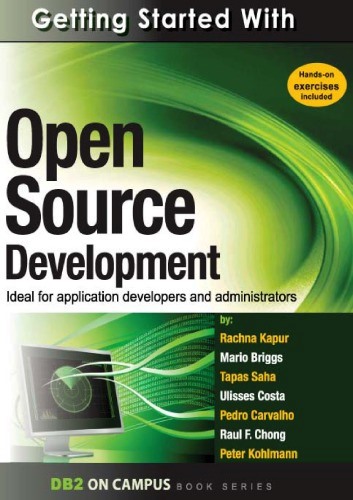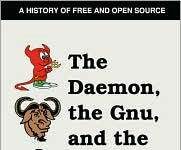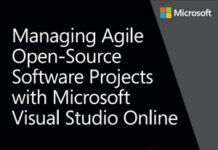| Book Name: | Getting Started with Open Source Development |
| Category: | Software Engineering |
| Free Download: | Available |
Getting Started with Open Source Development

Description of Book
Open source software development is a community-based approach to product development, from design and development to distribution. Developers from different parts of the world are passionate about working together and several successful projects including Firefox, Moodle and Drupal are being widely used today. In addition, many companies use open source software as the foundation to build their business models.
This book gets you started in the fascinating world of open source software development. By using the exercises provided and case studies, you will gain good practice in contributing to and starting open source projects.
Getting started with Open Source development couldn’t be easier. Read this free ebook to:
- Find out what DB2 Express-C is about
- Find out what open source development is all about
- Find out how to work with open source communities
- Learn more about open source business models and trends
- Start and contribute to open source projects
- Practice with hands-on exercises
Table of contents :
A book for the community
What’s next?
About the authors
Acknowledgements
1.1 A brief history about open source development
1.2 The evolution of the open source movement
1.3 FLOSS – Free, libre, open source software
1.4.1 Pros
1.5 Open source trends and perspectives
1.8 Summary
1.9 Review questions
2.1 Open source business models: The big picture
2.2 Dual licensing
2.3 Split open source software / commercial products
2.4 Product specialists
2.5 Platform providers
2.6 Business model relationship to license
2.7 Open source business model and proprietary software
2.9 Exercises
2.10 Review questions
3.1 Intellectual property, copyright and licensing: The big picture
3.2.1 History of open source licensing
3.2.2 Commonly used open source licenses
3.3 Choosing the right license
3.6 Review questions
4.1 Community driven development: The big picture
4.1.1 Developers’ group: Software design and development
4.1.2 Builders’ group: Software building
4.1.3 Testers’ group: Software Testing
4.1.4 Release management group: Packaging
4.1.5 Release management group: Releasing
4.2.1 Installation
4.2.2 Issue tracking
4.4 Summary
4.5 Review questions
5.1 Participating in open source development: The big picture
5.2 Open source communities
5.3 Effective communication
5.3.1 Communication etiquette and guidelines
5.6 Review questions
6.1 Starting your own open source project: The big picture
6.2 Providing the ecosystem for your open source project
6.3 Accepting contributions
6.6 Review questions
7.1 Ruby on Rails and the DB2 module
7.2 The ruby forge
7.3 Submitting a bug
8.1 What is the Technology Explorer for IBM DB2?
8.2.1 Requirements for setting up the TE
8.2.2 Some basic features and operations of the TE
8.3 You need a key insight to build a project
8.5 Make your project easy to adopt
8.6 Understand your business model
8.7 Keep your project current
Appendix A – Solutions to review questions
B.1 DB2: The big picture
B.3 Installing DB
B.4.1 Control Center8
B.4.2 Command Line Tools
B.5 The DB2 environment
B.7 Connecting to a database
B.8 Basic sample programs
B.9 DB2 documentation
References
What’s next?
About the authors
Acknowledgements
1.1 A brief history about open source development
1.2 The evolution of the open source movement
1.3 FLOSS – Free, libre, open source software
1.4.1 Pros
1.5 Open source trends and perspectives
1.8 Summary
1.9 Review questions
2.1 Open source business models: The big picture
2.2 Dual licensing
2.3 Split open source software / commercial products
2.4 Product specialists
2.5 Platform providers
2.6 Business model relationship to license
2.7 Open source business model and proprietary software
2.9 Exercises
2.10 Review questions
3.1 Intellectual property, copyright and licensing: The big picture
3.2.1 History of open source licensing
3.2.2 Commonly used open source licenses
3.3 Choosing the right license
3.6 Review questions
4.1 Community driven development: The big picture
4.1.1 Developers’ group: Software design and development
4.1.2 Builders’ group: Software building
4.1.3 Testers’ group: Software Testing
4.1.4 Release management group: Packaging
4.1.5 Release management group: Releasing
4.2.1 Installation
4.2.2 Issue tracking
4.4 Summary
4.5 Review questions
5.1 Participating in open source development: The big picture
5.2 Open source communities
5.3 Effective communication
5.3.1 Communication etiquette and guidelines
5.6 Review questions
6.1 Starting your own open source project: The big picture
6.2 Providing the ecosystem for your open source project
6.3 Accepting contributions
6.6 Review questions
7.1 Ruby on Rails and the DB2 module
7.2 The ruby forge
7.3 Submitting a bug
8.1 What is the Technology Explorer for IBM DB2?
8.2.1 Requirements for setting up the TE
8.2.2 Some basic features and operations of the TE
8.3 You need a key insight to build a project
8.5 Make your project easy to adopt
8.6 Understand your business model
8.7 Keep your project current
Appendix A – Solutions to review questions
B.1 DB2: The big picture
B.3 Installing DB
B.4.1 Control Center8
B.4.2 Command Line Tools
B.5 The DB2 environment
B.7 Connecting to a database
B.8 Basic sample programs
B.9 DB2 documentation
References
Getting started with Open Source development PDF
Related More Books
Thanks For Visiting Our Website https://www.freepdfbook.com To Support Us, Keep Share On Social Media.









![[PDF] Draw Buildings and Cities in 15 Minutes Draw Buildings and Cities in 15 Minutes pdf](https://www.freepdfbook.com/wp-content/uploads/2021/06/Draw-Buildings-and-Cities-in-15-Minutes-218x150.jpg)








![[PDF] Digital Image Processing An Algorithmic Introduction Using Java Digital Image Processing An Algorithmic Introduction Using Java](https://www.freepdfbook.com/wp-content/uploads/2022/06/Digital-Image-Processing-An-Algorithmic-Introduction-Using-Java.jpg)




![[PDF] 43 Years JEE ADVANCED + JEE MAIN Chapterwise & Topicwise Solved Papers 43 Years JEE ADVANCED (1978-2020) + JEE MAIN Chapterwise & Topicwise Solved Papers Physics PDF](https://www.freepdfbook.com/wp-content/uploads/2022/03/43-Years-JEE-ADVANCED-1978-2020.jpg)

![[PDF] Problems in Physical Chemistry for JEE (Main & Advanced) Problems in Physical Chemistry for JEE (Main & Advanced) Free PDF Book Download](https://www.freepdfbook.com/wp-content/uploads/2022/03/Problems-in-Physical-Chemistry-for-JEE-Main-Advanced.jpg)
![[PDF] Engineering Physics (McGraw Hill)](https://www.freepdfbook.com/wp-content/uploads/2021/05/bafc8c2685bb6823a9c56134f7fba5df.jpeg)

![[PDF] Engineering Chemistry By Shashi Chawla](https://www.freepdfbook.com/wp-content/uploads/2022/05/Theory-And-Practicals-of-Engineering-Chemistry-By-Shashi-Chawla-free-pdf-book.jpeg)
![[PDF] Chemistry: An Introduction to Organic, Inorganic & Physical Chemistry Chemistry: An Introduction to Organic, Inorganic & Physical Chemistry](https://www.freepdfbook.com/wp-content/uploads/2022/04/Chemistry-An-Introduction-to-Organic-Inorganic-Physical-Chemistry.jpg)
![[PDF] Essentials of Physical Chemistry Essentials of Physical Chemistry Free PDF Book by Bahl](https://www.freepdfbook.com/wp-content/uploads/2022/04/Essentials-of-Physical-Chemistry-bahl.jpg)
![[PDF] Biological control of plant-parasitic nematodes: soil ecosystem management in sustainable agriculture Biological control of plant-parasitic nematodes: soil ecosystem management in sustainable agriculture](https://www.freepdfbook.com/wp-content/uploads/2022/05/Biological-control-of-plant-parasitic-nematodes-soil-ecosystem-management-in-sustainable-agriculture.jpg)
![[PDF] Human Anatomy: Color Atlas and Textbook Human Anatomy: Color Atlas and Textbook Free PDF Book](https://www.freepdfbook.com/wp-content/uploads/2022/05/Human-Anatomy-Color-Atlas-and-Textbook.jpg)
![[PDF] Concepts of Biology Book [Free Download]](https://www.freepdfbook.com/wp-content/uploads/2022/05/Concepts-of-Biology.jpg)
![[PDF] Essentials of Biology [Free Download] Essentials of Biology Free PDF BOok Download](https://www.freepdfbook.com/wp-content/uploads/2022/05/Essentials-of-Biology-Free-PDF-Book-Downlaod.jpg)
![[PDF] Human Biology Book [Free Download]](https://www.freepdfbook.com/wp-content/uploads/2022/05/PDF-Human-Biology-Book-Free-Download.jpg)


